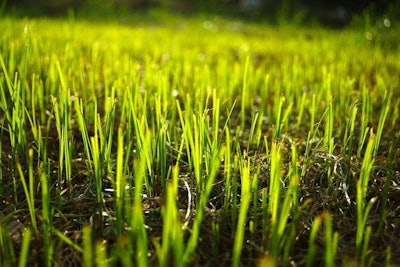
Overseeding allows customers to keep a dense, green turf even during the dead of winter. It is commonly used for golf courses and athletic fields to minimize damage from foot traffic and reduce weed invasion during winter dormancy, but homeowners are known to want this service too.
The one agreed upon warm-season grass that can tolerate overseeding is Bermuda grass, while experts are divided on whether zoysia grass can recover from overseeding. Some say that zoysia grows too thickly to allow ryegrass to penetrate the soil and germinate.
It is recommended to never overseed St. Augustine lawns due to the fact it can be hard to get good seed contact without having to scalp and damage the existing yard.
The main choice for which cool-season turf to overseed with is generally between annual ryegrass and perennial ryegrass.
Each type of ryegrass comes with its own set of pros and cons. Annual ryegrass has a light green color and is a fast grower that requires frequent mowing. It is the inexpensive choice for homeowners and commercial properties that are fine with moderate turf quality.
Perennial ryegrass has a deep green color. While more expensive, it can create the lush quality turf a customer may be looking for. Newer cultivars of this ryegrass have resulted in it persisting long in the spring and competing with Bermuda grass that is greening up.
“It all boils down to a battle between grasses, and we normally want the permanent grass to win,” says Dr. Tom Koske, LSU Agricultural Center horticulturalist.
Transitioning the lawn back
Ideally, perennial ryegrass will disappear on its own as the Bermuda grass greens up, but inconsistent spring and early summer weather can allow it to either hang on for too long or die off before the Bermuda can grow in.
To ensure that this transition from the ryegrass back to Bermuda grass goes as smoothly as possible, there are a number of steps to take that help discourage the overseeded grass from overstaying its welcome.
The Clemson University Cooperative Extension Service advises not to fertilize the ryegrass any later than January.
Bermuda growth begins to grow actively when nighttime low air temperatures are higher than 60 degrees Fahrenheit for seven consecutive days.
During the spring, gradually lower your mowing heights, removing some of the shade canopy caused by ryegrass. Increasing the mowing frequency can also help reduce the turf canopy.
Mowing the cool-season grass as the soil warms will weaken the turf and also helps with soil warming. There’s no need to scalp the yard, just have it low enough to thin out the grass.
When the warm-season grass resumes growth, apply nitrogen fertilizer at a weekly rate of 0.25 lb. N/1,000 ft2. Once 80 percent of the lawn is the permanent grass, the University of Arizona advises lightly vericutting to remove the ryegrass, applying fertilizer at a 0.25 to 0.50 lb. N/1,000 ft2 and decreasing watering for one week.
Repeat the fertilization and water cycle to stress the ryegrass.
To speed up the transition process, there are several herbicides that can be used when the turf is near full green-up, including imazaquin. No matter what method is used, Koske recommends stepping up your customer’s fertilizer program after the ryegrass is gone to reduce the chance of thin, transitional turf.
Is overseeding worth it?
According to turf researcher Dr. Clint Waltz, there’s no real advantage to overseeding a warm-season turf. Overseeding harms the permanent turf as it competes with the ryegrass for nutrients, water and light.
Weak lawns in particular that are already stressed from drought, disease, soil compaction or overwatering are not suited for overseeding.
Another drawback from overseeding is the fact that pre-emergent herbicides cannot be applied for winter weeds before the lawn is overseeded, as it will kill the grass seed along with the weed seeds.
On the other hand, if your client wishes to have a green lawn year-round or experiences a good deal of traffic during the winter on their turf, overseeding can be appropriate.
One thing to keep in mind is that once a lawn has been overseeded, it will need to be overseeded in the following years so ryegrass seeds that did not germinate the previous year don’t grow in big clumps and look weedy. If a homeowner wishes to let their previously overseeded yard lay fallow, pre-emergent herbicide should be applied to ensure both the winter weeds and ryegrass seeds do not germinate.










